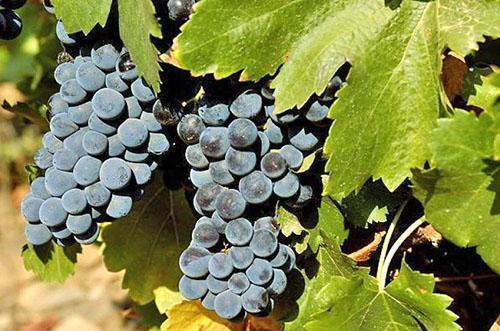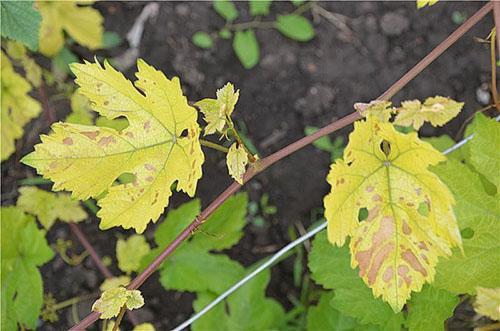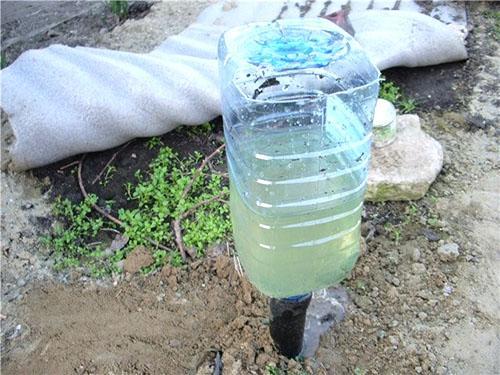We study grape diseases by photo and description
 White, pink. people use black grape varieties for different purposes. In the summer cottages, grapes are mainly grown for fresh consumption, for making juices and aromatic homemade wine. To get a good harvest, it is necessary to study not only the rules of planting and care, but also to find out the weak points of plants, their enemies and diseases. To the attention of site visitors, we offer a series of articles on pests and diseases of grapes to help them learn how to prevent diseases in a timely manner and provide assistance to their garden pets. Each article describes in detail several diseases and ways to effectively fight.
White, pink. people use black grape varieties for different purposes. In the summer cottages, grapes are mainly grown for fresh consumption, for making juices and aromatic homemade wine. To get a good harvest, it is necessary to study not only the rules of planting and care, but also to find out the weak points of plants, their enemies and diseases. To the attention of site visitors, we offer a series of articles on pests and diseases of grapes to help them learn how to prevent diseases in a timely manner and provide assistance to their garden pets. Each article describes in detail several diseases and ways to effectively fight.
Non-communicable diseases
These are grape diseases caused by poor growing conditions, and not by the vital activity of harmful living organisms.
Chlorosis

The most common causes of non-infectious chlorosis are as follows:
- Soil salinization.
- Excess moisture.
- Excessive, in comparison with iron, the content of copper, manganese, phosphorus, lime in the soil.
Under such conditions, the assimilation of iron from the soil is disturbed, which leads to chlorosis. Chlorosis of grapes is treated with 3-4 foliar dressings with solutions of iron preparations, the cheapest of all - iron sulfate. It is convenient to combine top dressing with the introduction of other microelements, stimulating and therapeutic drugs.
Drought
The viticulture zone does not always have the right amount of moisture for the plants. The lack of water is externally expressed as follows.
Shoots - growth and development slows down sharply, crowns grow dull, wither, dry out.
Antennae - grow stiff, dry up, starting from the ends, disappear.
Leaves - they turn yellow massively, starting from the edges of the lower leaves, can thicken, curl, fall off.
Berries - the ovary falls off in early spring. In case of drought in the phase, the peas wilt and dry out, starting from the bottom of the bunch. Drought in the filling phase causes a characteristic lesion: darkening and brown color of a part of the berry, as if pressed by a fingernail. When the skin is removed, the insides are healthy. As a result, the berries dry out like raisins, but alas, they become inedible.
The winter drought is accompanied by cracking of the soil, while small roots are torn apart.
 Control measures - watering and preserving the moisture available in the soil: mulching; shelter for the winter with soil; shallow loosening in order to disrupt the capillaries of the upper soil layer, thereby making evaporation more difficult. Watering into the root zone through specially dug tubes is preferable: more economical and efficient.
Control measures - watering and preserving the moisture available in the soil: mulching; shelter for the winter with soil; shallow loosening in order to disrupt the capillaries of the upper soil layer, thereby making evaporation more difficult. Watering into the root zone through specially dug tubes is preferable: more economical and efficient.
Sunburn
 During the hottest months, grapes can overheat in the sun. In appearance, the berries look like scalded boiling water, later they wrinkle and dry out. They are noticeably hot when touched. The leaves are as if they had been under a heated iron: they dry up green, turn brown over time. Leaves with damaged petioles are the first to suffer: they have difficulty in supplying water to reduce the temperature.All damage is only on the sunny side of the bush, while such a picture does not happen with infectious diseases. The bush tries to defend itself by vigorously evaporating water to cool it. Does not grow, does not accumulate nutrients.
During the hottest months, grapes can overheat in the sun. In appearance, the berries look like scalded boiling water, later they wrinkle and dry out. They are noticeably hot when touched. The leaves are as if they had been under a heated iron: they dry up green, turn brown over time. Leaves with damaged petioles are the first to suffer: they have difficulty in supplying water to reduce the temperature.All damage is only on the sunny side of the bush, while such a picture does not happen with infectious diseases. The bush tries to defend itself by vigorously evaporating water to cool it. Does not grow, does not accumulate nutrients.
Control measures. The main thing is the availability of a sufficient amount of water, therefore - watering, mulching, destruction of the soil crust fur. processing. In the heat, we transfer all the freshly grown shoots with a "visor" to the sunny side. You can cover the affected bunches with everything that is available: with newspapers, leaves, etc. We do not cut the aisles, we will wait until the weather is cooler. When laying - choose such a row spacing that the rows sufficiently shade each other.
Infectious diseases of grapes
Mildew, (downy mildew, pernosporosis)
 Perhaps the most common disease. The pathogen hibernates in soil and plant debris, is resistant to any weather, lasts 2-5 years, and spores are carried by wind up to 100 km. In spring, oospores germinate, with the help of jigucks in the smallest drops of moisture (dew, watering, rain), they swim to the stomata and germinate into plants, where they penetrate into living cells, destroying them. Treatment with contact fungicides after germination of the fungus into the plant is ineffective.
Perhaps the most common disease. The pathogen hibernates in soil and plant debris, is resistant to any weather, lasts 2-5 years, and spores are carried by wind up to 100 km. In spring, oospores germinate, with the help of jigucks in the smallest drops of moisture (dew, watering, rain), they swim to the stomata and germinate into plants, where they penetrate into living cells, destroying them. Treatment with contact fungicides after germination of the fungus into the plant is ineffective.
 After the introduction inside the plant, thin filaments of the fungus develop - hyphae, at night the spore-bearing organs move outward. There are so many of them that for a person it looks like an easily removable gray plaque on the lower surface of the leaf. The upper part of the leaves acquires an oily shade, at first small, with a light center, the spots on the leaf increase, gradually merging.
After the introduction inside the plant, thin filaments of the fungus develop - hyphae, at night the spore-bearing organs move outward. There are so many of them that for a person it looks like an easily removable gray plaque on the lower surface of the leaf. The upper part of the leaves acquires an oily shade, at first small, with a light center, the spots on the leaf increase, gradually merging.
On shoots, yellowish elongated spots appear, gradually acquiring a brown color. Affected berries dry out in dry weather, and rot and mold in wet weather. With late infection of berries, bluish gray depressed spots appear near the stalk, at the end of the berries they warp, rot, fall off. Complete loss of yield is possible.
Control measures - multiple treatment with fungicides.
The first is carried out before signs of the disease appear!
We use the rule of 3 tens: temperature 10 ˚С, shoot length 10 cm, precipitation 10 mm. The conditions are met - it's time to process. Subsequent treatments - depending on the weather. In a favorable year for the disease, the number of treatments can reach 6-8 ...
Prevention. First of all, the selection of resistant varieties. But do not rely too much, this does not completely remove the problem: in bad years, the development of the disease on resistant and unstable varieties differs in the rate of spread, a little more - in the severity and percentage of the destroyed crop. So, most likely, you still have to process.
Oidium, or grape powdery mildew.
 With the beginning of the growth of grapes, shoots and leaves lagging behind in growth appear. Such leaves curl. Leaves, berries, bunches look like they are showered with flour, hence the name of the disease. This plaque is the finest strings of the fungus. It is attached to the plant with special suction cups called apressoria. Of these, haustoria are injected into the berries, through which the mushroom feeds. The growth of berries with the simultaneous destruction of the walls leads to ruptures, the seeds are exposed. At the edges of the hyphae, constrictions appear, these pieces are easily torn off and carried by the wind. Once on other vines, new bushes germinate and infect.
With the beginning of the growth of grapes, shoots and leaves lagging behind in growth appear. Such leaves curl. Leaves, berries, bunches look like they are showered with flour, hence the name of the disease. This plaque is the finest strings of the fungus. It is attached to the plant with special suction cups called apressoria. Of these, haustoria are injected into the berries, through which the mushroom feeds. The growth of berries with the simultaneous destruction of the walls leads to ruptures, the seeds are exposed. At the edges of the hyphae, constrictions appear, these pieces are easily torn off and carried by the wind. Once on other vines, new bushes germinate and infect.
In case of partial damage, when part of the grapes is used for wine, sorting with the selection of damaged berries is necessary. Otherwise, the wine will have a moldy taste, absolutely invaluable for connoisseurs ...
Measures to combat grape mildew. Correct, well-ventilated grape formation, destruction of vegetation in the aisles helps to prevent or reduce disease. Fungicides and copper preparations that help against mildew are not suitable for treating grape powdery mildew. Sulfur preparations give an excellent effect. The finer the sulfur particles, the better. Powdered sulfur for pollination must be properly stored so that it does not stick together in the breasts, always in a dry place.The processing temperature matters. The air must be warmed up to 20 ˚С, otherwise it will not work. At the same time, in extreme heat, burns are possible, in hot summer we process plantings in the morning or evening hours. It is good to use special colloidal sulfur pastes when making tank mixtures from mildew and oidium. In this case, we save time and effort, reducing the number of treatments.
Grape anthracnose (bird's eye, hail disease).
 The disease is activated after heavy rains with hail, hence one of the names. On the leaves, it is manifested by the appearance of small dry brown spots surrounded by a darker border. Later, the middle of the spot dies off, becomes gray, and often ruptures. Leaves become full of holes. On the shoots, depressed spots with a dark border appear, the shoots dry out and break. Similar spots, gray-brown, depressed, with a dark border appear on berries. A bit like the image of a bird's eye, which gives rise to another name for it.
The disease is activated after heavy rains with hail, hence one of the names. On the leaves, it is manifested by the appearance of small dry brown spots surrounded by a darker border. Later, the middle of the spot dies off, becomes gray, and often ruptures. Leaves become full of holes. On the shoots, depressed spots with a dark border appear, the shoots dry out and break. Similar spots, gray-brown, depressed, with a dark border appear on berries. A bit like the image of a bird's eye, which gives rise to another name for it.
 Control measures. When grapes are infected with anthracnose, treatment is carried out by treatments with copper preparations or systemic fungicides. It is not for nothing that the disease is called hail disease; after a heavy rain with hail, we immediately carry out the treatment. Without delay and despite the time after the previous one.
Control measures. When grapes are infected with anthracnose, treatment is carried out by treatments with copper preparations or systemic fungicides. It is not for nothing that the disease is called hail disease; after a heavy rain with hail, we immediately carry out the treatment. Without delay and despite the time after the previous one.
 The grapes need our care, otherwise it is difficult to hope for a good harvest. It is clear that this includes only spraying with drugs. Proper planting, pruning, fertilizing, watering - everything matters. A strong, nutrient-rich plant that resists any disease better.
The grapes need our care, otherwise it is difficult to hope for a good harvest. It is clear that this includes only spraying with drugs. Proper planting, pruning, fertilizing, watering - everything matters. A strong, nutrient-rich plant that resists any disease better.
Came from watch (3 months) and gasped .. what to do? Can you save even the grapes themselves, about the harvest it is clear that it died, or will it die?
This year the grapes have suffered a lot. You cannot save the crop. Now you need to remove the bunches affected by mildew and other diseases. at the same time peel dry leaves. Treat the bushes with systemic fungicides or a solution of copper sulfate (iron sulfate also works to protect and disinfect). In the fall, after the foliage has completely fallen off, carry out more processing, having previously removed the dead shoots. The root system needs to be given a good feeding so that it retains the strength for the spring awakening. In the spring, the kidneys are again treated with iron vitriol.
Thank you for the advice. I will process and heal.
I do not understand what has been treated with grapes, against pests and diseases. The infected leaves have all been removed! But the problem doesn't go away! What to do?
Perhaps the grapes are sick with rubella. Since the bush is young and there are no berries on it yet, you can now treat the leaves on both sides with one of the preparations to choose from: Bordeaux mixture, Fundazol or Omite. In parallel with this, carry out potassium-phosphorus feeding, since the disease often arises as a result of a deficiency of these trace elements.
Hello, please tell me what kind of disease is on the grapes and how to treat
Hello. This year I also have such a problem with grapes. If you found out what it is, tell me.
Such changes in leaf plates are observed after exposure to herbicides. The disease is called goose feet.
Thanks for the help, but now what to do with it? Growth has completely stopped. The vine falls and breaks, the leaves dry. A type of drying plant.
This is how herbicides work. They destroy the plant. This is normal photosynthesis. Getting on the leaves, the poison moves into the roots, the dying off of the entire plant begins.
Good afternoon, what made the grapes sick
Oidium or powdery mildew. The article describes the means of struggle. Now processing is too late, because the ripening period has come.
maybe a sunburn? I am amuse myself with hope, just the groves were covered with foliage, and after the leaves were removed, it appeared.
This is the whole problem. Yes, you processed the Bordeaux mixture, but alas, it turned out to be ineffective. The reason is surface spraying. When dealing with powdery mildew, careful processing is needed and leaf plates on both sides and gron. The main reason for the development of oidium is thickening.
there is a trace of Bordeaux mixture on the leaves
thank
Please tell me what to do and how to process young grapes now in August. There are no berries. But then the weak growth is very feeble. Thank you in advance.
Hello! The grapes are 4 years old. Black spots and twisting and drying of the leaf have appeared everywhere on the leaves and ovary. Growth has clearly slowed down.
on the leaves of the grapes black spots twisting and drying out photo like that of Igor from April 21, 2018, I beg you to answer
Rolling leaves is a viral lesion. You can help the plant by bringing ash under the bush. Start with small doses.
Young leaves in holes, no description of diseases fits. Can you tell me?
Good day. Need help. Spots appeared on the leaves. I did not find it in the description of the diseases. Tell me what it is and how to fight?
It looks like a spider mite. After treatment, young leaves will be clean and the affected ones will remain in the hole.
Good day! Young raisins - there are no grapes yet, what is this disease? Thank!!!!
Tell me what could be the reason for the sharp wilting of the berries. 5-6 days ago, everything was normal. grade Moldova.
I missed. and now merciless pruning and chemistry, unfortunately. in a combination of sulfur and strobe in turn and every day in the morning, "babysit" by plucking / grandmother's recipe /. there is another misfortune - the leaves are cut and between the veins they become thinner, like parchment. than anything like this before